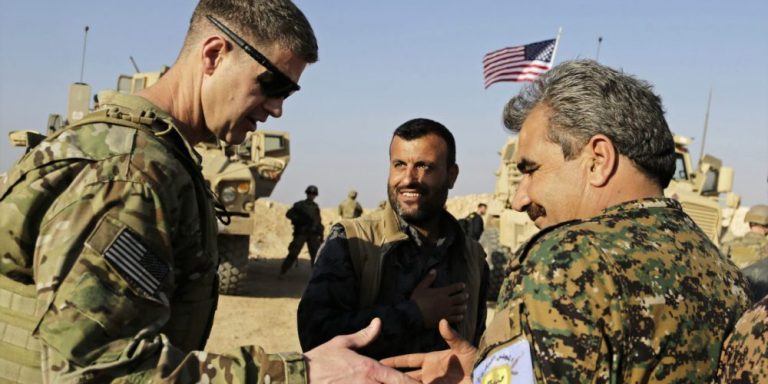INTELBRIEF
February 9, 2018
TSC IntelBrief: The U.S. Hits Back in Syria

- In a sign of what might lie ahead, the United States responded to a large attack on the Syrian Democratic Forces (SDF) by Syrian regime troops with a significant air and artillery counterattack.
- The U.S. counterattack, which the regime labeled ‘a war crime,’ killed at least 100 regime supporters after they attacked ‘a well-established SDF headquarters’ east of the Euphrates River.
- Russian mercenaries were reportedly among the forces that attacked the SDF position. Moscow labeled the counterattack an example of the U.S. trying to steal economic resources from Syria.
- The longer-term U.S. presence in Syria is increasingly problematic as it tries to navigate fierce opposition from the regime, Russia, Iran, and even Turkey.
The United States military presence in Syria has been problematic for several reasons: the U.S. has tried to focus on the so-called Islamic State while nearly all other internal and external actors focused on the civil war; the Assad regime objects to U.S. presence; and, the U.S. is making long-term plans that aren’t covered by the 2001 Authorization of the Use of Military Force (AUMF) used by the White House to justify the operation. The anti-Islamic State coalition that the U.S. built has been militarily successful, with the terrorist group territorially removed from most of Syria. As the battles against the Islamic State narrow in scope and territory, the Assad regime—emboldened by its Russian and Iranian backers—is focusing on taking those holdings from the U.S.-led coalition. This sets up an entirely different conflict than the one the U.S. had in mind when it began military operations in Syria in late 2014.
The U.S.-supported Syrian Democratic Forces (SDF) now hold land east of the Euphrates River in Deir Ezzour—among other places. The Euphrates River serves as an unofficial but de facto demarcation line between the Assad/Russian/Iranian forces and the SDF. While this buffer has helped to avoid a direct clash between Russian and American military personnel, it has failed to prevent clashes between Assad supporters and the SDF and their embedded U.S. advisors.
On February 8, 2018, the U.S. Central Command (CENTCOM) announced that it had killed 100 ‘pro-regime’ forces after they attacked a ‘well-established SDF headquarters’ approximately 8 kilometers east of the Euphrates River demarcation line. The Syrian Observatory for Human Rights reported that the pro-regime forces were made up of local tribes as well as Afghan Shiite militia fighting for the regime. CBS News has reported that unnamed US officials stated Russian mercenaries were among the forces that attacked the SDF position.
These forces intended to drive out the SDF from the oil fields of Khusham and the Conoco natural gas field, resources that are extremely important to the future of Syria. CENTCOM stated that after the pro-regime forces, reported to number 500, fired 20-30 tank and artillery rounds into SDF positions in which U.S. advisors were present, the U.S. responded with a massive retaliation that included airstrikes as well as heavy artillery including the High Mobility Artillery Rocket System (HIMARS). In its statement about the attack, CENTCOM said ‘coalition advisers were with the SDF in an advise, assist and accompany capacity, and this action was taken in self-defense.’
The statement also made note that ‘coalition officials alerted Russian officials of the SDF presence in Khusham via the de-confliction line well in advance of the PRF (pro-regime forces) attack’ and that the Americans and Russians were in communications throughout the incident, avoiding direct conflict. The Russian Defense Ministry issued a statement saying that the incident ‘again showed that the U.S. is maintaining its illegal presence in Syria not to fight the Islamic State group, but to seize and hold Syrian economic assets.’ The Syrian Foreign Ministry sent a letter to the United Nations denouncing the attack as a ‘war crime’ committed by the SDF and called for an investigation into this ‘massacre.’ This comes amid renewed tensions between Washington and the Assad regime and supporting nations over the regime’s continued use of chemical weapons against civilian targets in parts of Idlib and Eastern Ghouta.
The U.S. has stated it wants to maintain a longer-term military presence in Syria after the campaign to militarily defeat the Islamic State is finished, ostensibly to prevent a return by the group but also to counter Iranian influence in the country. This plan faces tremendous challenges, starting with the shaky legal foundation for the U.S. involvement—resting on the 2001 AUMF—and the fact that the U.S. and its primary ally, the Kurds, face serious opposition from the regime, Russia, Iran, and, increasingly, Turkey, who views any Kurdish territorial holdings along its southern border as a significant threat to its national security and self-interest.
For tailored research and analysis, please contact: info@thesoufancenter.org
[video width="960" height="540" mp4="https://thesoufancenter.org/wp-content/uploads/2018/02/Final-Edit-1-128.mp4" poster="https://thesoufancenter.org/wp-content/uploads/2018/02/AP_18038621590692-1-e1518130888513.jpg"][/video]